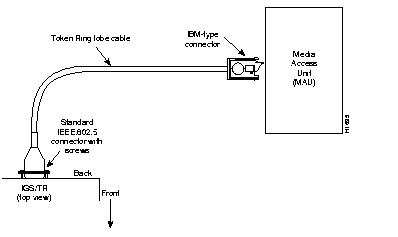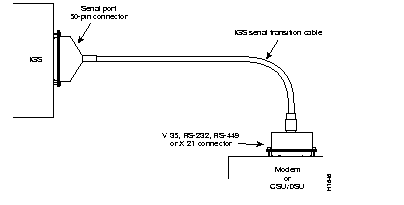|
|

This chapter includes tasks that should be completed before initial system startup:
Your system arrives in a box that contains the system components and electrical connectors. When you unpack the box, check the packing list that accompanies all shipments to ensure you received all the pieces you ordered. Inspect all items for shipping damage.
If anything appears damaged, or if you encounter problems when installing or configuring your system, call Cisco Systems at the number provided in the beginning of this document, or call your regional representative.
When viewed from the rear, the power cable and power switch appear on the right side of the IGS/TR chassis. The system console port, auxiliary (AUX) port, Token Ring port, and serial line port appear to the left of the power cable and switch. Refer to Figure 1-2 for the rear view of the IGS/TR.
The system console port is the top, left female 25-pin D connector on the back of the chassis. The auxiliary port is located directly below the console port.
When setting up your system, consider electromagnetic interference and, when using RS-232 connections, distance limitations.
When you run cables for any significant distance in an electromagnetic field, interference can occur between the field and the signals on the cables. This fact has two implications for the construction of terminal plant cabling:
If you use twisted-pair cables in your plant cabling with a good distribution of grounding conductors, then the plant cabling is unlikely to emit radio interference. Ground the conductor for each data signal when exceeding the distances listed in Table 1-1.
To predict and remedy strong electromagnetic interference, consult experts in radio frequency interference (RFI).
If you have cables exceeding the distances in Table 1-1, or you have cables that pass between buildings, then give special consideration to the effect of a lightning strike in your vicinity. The electromagnetic pulse caused by lightning or other high-energy phenomena can easily couple enough energy into unshielded conductors to destroy electronic devices. If you have had problems of this sort in the past, then you might want to consult experts in lightning suppression and shielding.
Most data centers cannot resolve the infrequent but potentially catastrophic problems just described without pulse meters and other special equipment. Therefore, take precautions to avoid these problems by providing a properly grounded and shielded environment, with special attention to issues of electrical surge suppression.
As with all signaling systems, RS-232 can travel a limited distance at any given bit rate; generally, the slower the data rate, the greater the distance. Table 1-1 shows the standard relationship between bit rate and distance.
| Data Rate | Distance (Feet) | Distance (Meters) |
|---|---|---|
| 2400 | 200 | 60 |
| 4800 | 100 | 30 |
| 9600 | 50 | 15 |
| 19200 | 25 | 7.6 |
| 38400 | 12 | 3.7 |
Before connecting the console and auxiliary ports, refer to the considerations described in the following sections.
Each IGS/TR includes an asynchronous system console port wired as a Data Communications Equipment (DCE) device. The default parameters for this port are:
Refer to Table A-3 in Appendix A to specify other terminal speeds using the configuration register.
Table 1-2 lists the pinouts for the console port.
| Pin | Signal Name | Direction |
|---|---|---|
| 2 | Transmitted Data | Input |
| 3 | Received Data | Output |
| 4 | Request to Send | Shorted together internally with Pin 5 |
| 5 | Clear to Send | -- |
| 6 | Shorted to Pin 8 | Output |
| 7 | Ground | -- |
| 8 | Carrier Detect | Output |
| 15 | Transmit Clock | Output |
| 17 | Shorted to Pin 15 | Output |
| 20 | Data Terminal Ready | Input |
An auxiliary console port is included on all IGS/TR units. This is a Data Terminal Equipment (DTE) port to which you can attach an RS-232 port from a Channel Service Unit/Data Service Unit (CSU/DSU) or protocol analyzer for network access. The following table lists the pinouts for this auxiliary console port.
| Pin | Signal Name | Direction |
|---|---|---|
| 2 | Transmitted Data | Output |
| 3 | Received Data | Input |
| 4 | Request to Send | Output |
| 5 | Clear to Send | Input |
| 6 | Shorted to Pin 8 | Output |
| 7 | Ground | -- |
| 8 | Carrier Detect | Input |
| 15 | Transmit Clock | Input |
| 17 | Shorted to Pin 15 | Input |
| 20 | Data Terminal Ready | Output |
The Token Ring port is located to the right of the serial port. Use a standard 9-pin Token Ring lobe cable to connect the IGS/TR directly to a Media Attachment Unit (MAU), as shown in Figure 1-1.
The serial interface port is located to the left of the Token Ring port on the back of the
IGS/TR. The serial port is a 50-pin D-subminiature connector. This port is DTE that expects clocking to be provided by a CSU/DSU or modem.
You must use a special serial cable to connect the IGS/TR to a modem or CSU/DSU, as shown in Figure 1-2. This cable is available from Cisco Systems; see Chapter 4 for cable specifications.

 | Caution Never operate the IGS/TR unless the unit is completely closed. This ensures both adequate cooling and your safety. |
To prepare for initial startup and configuration, attach an RS-232 ASCII terminal to the system console port. Flow control is not possible on the console port; however, you can specify padding for output characters with the EXEC command terminal [no] padding, which sets character padding on the current terminal line. Refer to the Router Products Configuration and Reference for details on specifying padding.
Follow these steps to install the IGS/TR system:
Step 1: If you have not already done so, unpack your system according to the instructions earlier in this chapter.
Step 2: Attach the cables as follows:
n Attach your terminal to the RS-232 console port.
n Attach your Token Ring cables to the 9-pin D-type connectors on the
IGS/TR back panel.
n Attach the 50-pin end of the serial cable to the synchronous serial port.
n Attach the RS-232, RS-449, V.35, or X.21 end of the cable to the Channel Service Unit/Data Service Unit (CSU/DSU) or modem.
Step 3: Plug the IGS/TR power cord into a 3-terminal, single-phase power source that provides power within the range of 90-132 or 175-264 VAC at 47-63Hz.
Step 4: Turn on the IGS/TR power switch.
Step 5: Check the OK light located on the left side of the IGS/TR front panel to determine that it is on after a few seconds delay. Another indication that the unit is powered on is the sound of the fan running.
Step 6: Refer to the Getting Started with the Cisco Gateway System publication, November 1990, for instructions on using the setup command facility for initial configuration.
|
|